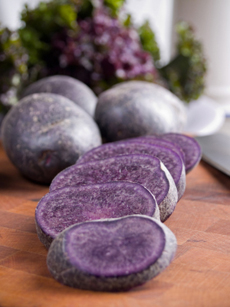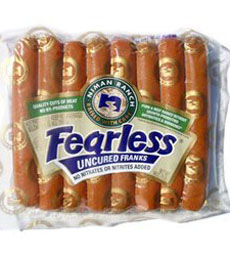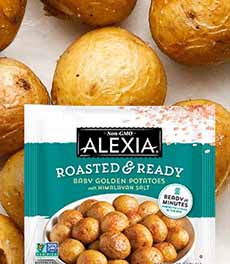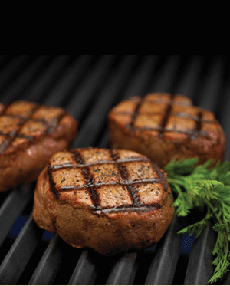|
Whenever we’re asked to a July 4th party, we always bring our Red, White & Blue Potato Salad. It’s special on Independence Day and potato salad occasion.
While we generally enjoy sharing, we keep our exact recipe a secret. We worked for years to get the dressing right!
But the United States Potato Board sent us a substitute red, white and blue potato salad recipe. It mixes three different potato types with onions, bell peppers, and ham in a balsamic vinaigrette. This fancy potato salad is a world away from a potato-mayonnaise mix, a delight for potato salad fans.
The recipe was created by Jill Melton, MS, RD, former senior food editor of Cooking Light and director of communications for Food Insight. We had bacon on hand and substituted it for the ham: delicious!
And a bonus: Here’s another red, white and blue potato salad recipe, with white stars cut from non-browning Envy apples.
> Fun potato trivia (below).
> The history of potatoes.
> The different types of potatoes.
> 60 more red, white and blue recipes.
RED, WHITE & BLUE POTATO SALAD RECIPE
Ingredients
1 pound small white potatoes (Creamer,* Fingerling or Yukon Gold)
1 pound small red potatoes
12 ounces Purple Peruvian potatoes
3 tablespoons walnut oil or olive oil, divided
2 ounces chopped ham or bacon
1/3 cup chopped walnuts
8 garlic cloves, finely chopped
3 tablespoons sherry or white balsamic vinegar
1 cup finely chopped red or orange bell pepper
4 green onions, chopped
1/2 teaspoon salt
1/4 teaspoon freshly ground pepper
Preparation
1. Cut the potatoes into 1-1/2 inch pieces (do not peel). Steam for 25 minutes or until the potatoes are tender.
2. Heat 1 tablespoon of oil in a medium skillet. Add ham, walnuts, and garlic. Sauté 10 minutes. Add sherry vinegar, and stir well.
3. In a large bowl, toss ham mixture with potatoes, additional 2 tablespoons of oil, red pepper, green onions, salt, and pepper. Serve warm or cold with grilled steak, burgers, chicken, or fish.
Find more delicious potato recipes from the U.S. Potato Board.
|
|

[1] A potato salad for any festive occasion (photo © U.S. Potato Board).

[2] Petite potatoes in red, white, and blue (photo © Potato Goodness).

[3] Some varieties of purple potatoes have a more blue hue, but for July 4th, we’ll pretend these are blue (photo © Mona Makela | iStock Photo).
|
________________
*Creamer potatoes are potatoes that are harvested while young, tender, and small—often as little as one inch in diameter. The flesh contains a lower level of starch, which makes them suitable for boiling. Creamer potatoes are typically Yukon Gold or red potatoes, which are called gold creamers or red creamers, respectively.
|








